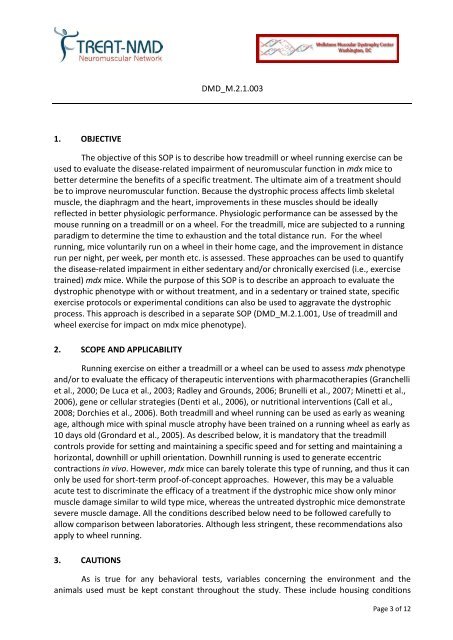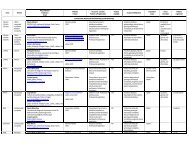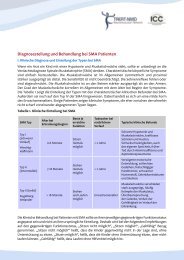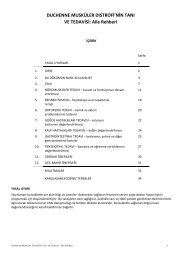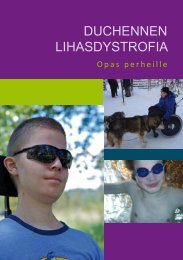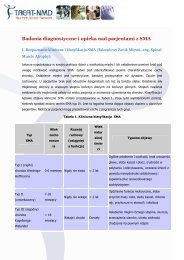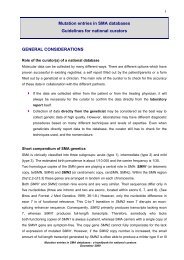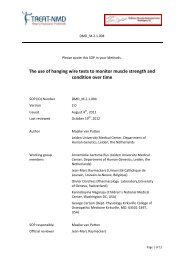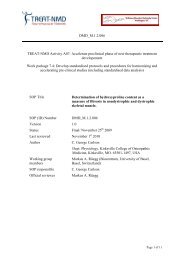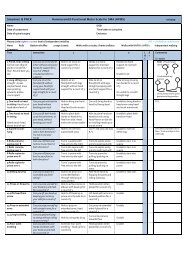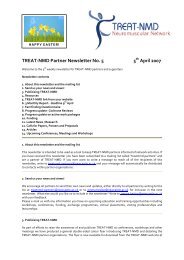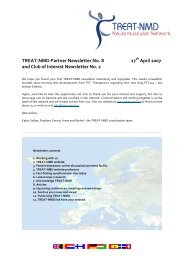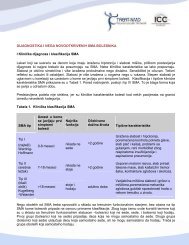Use of treadmill and wheel exercise to assess ... - Treat-NMD
Use of treadmill and wheel exercise to assess ... - Treat-NMD
Use of treadmill and wheel exercise to assess ... - Treat-NMD
Create successful ePaper yourself
Turn your PDF publications into a flip-book with our unique Google optimized e-Paper software.
DMD_M.2.1.003<br />
1. OBJECTIVE<br />
The objective <strong>of</strong> this SOP is <strong>to</strong> describe how <strong>treadmill</strong> or <strong>wheel</strong> running <strong>exercise</strong> can be<br />
used <strong>to</strong> evaluate the disease-related impairment <strong>of</strong> neuromuscular function in mdx mice <strong>to</strong><br />
better determine the benefits <strong>of</strong> a specific treatment. The ultimate aim <strong>of</strong> a treatment should<br />
be <strong>to</strong> improve neuromuscular function. Because the dystrophic process affects limb skeletal<br />
muscle, the diaphragm <strong>and</strong> the heart, improvements in these muscles should be ideally<br />
reflected in better physiologic performance. Physiologic performance can be <strong>assess</strong>ed by the<br />
mouse running on a <strong>treadmill</strong> or on a <strong>wheel</strong>. For the <strong>treadmill</strong>, mice are subjected <strong>to</strong> a running<br />
paradigm <strong>to</strong> determine the time <strong>to</strong> exhaustion <strong>and</strong> the <strong>to</strong>tal distance run. For the <strong>wheel</strong><br />
running, mice voluntarily run on a <strong>wheel</strong> in their home cage, <strong>and</strong> the improvement in distance<br />
run per night, per week, per month etc. is <strong>assess</strong>ed. These approaches can be used <strong>to</strong> quantify<br />
the disease-related impairment in either sedentary <strong>and</strong>/or chronically <strong>exercise</strong>d (i.e., <strong>exercise</strong><br />
trained) mdx mice. While the purpose <strong>of</strong> this SOP is <strong>to</strong> describe an approach <strong>to</strong> evaluate the<br />
dystrophic phenotype with or without treatment, <strong>and</strong> in a sedentary or trained state, specific<br />
<strong>exercise</strong> pro<strong>to</strong>cols or experimental conditions can also be used <strong>to</strong> aggravate the dystrophic<br />
process. This approach is described in a separate SOP (DMD_M.2.1.001, <strong>Use</strong> <strong>of</strong> <strong>treadmill</strong> <strong>and</strong><br />
<strong>wheel</strong> <strong>exercise</strong> for impact on mdx mice phenotype).<br />
2. SCOPE AND APPLICABILITY<br />
Running <strong>exercise</strong> on either a <strong>treadmill</strong> or a <strong>wheel</strong> can be used <strong>to</strong> <strong>assess</strong> mdx phenotype<br />
<strong>and</strong>/or <strong>to</strong> evaluate the efficacy <strong>of</strong> therapeutic interventions with pharmacotherapies (Granchelli<br />
et al., 2000; De Luca et al., 2003; Radley <strong>and</strong> Grounds, 2006; Brunelli et al., 2007; Minetti et al.,<br />
2006), gene or cellular strategies (Denti et al., 2006), or nutritional interventions (Call et al.,<br />
2008; Dorchies et al., 2006). Both <strong>treadmill</strong> <strong>and</strong> <strong>wheel</strong> running can be used as early as weaning<br />
age, although mice with spinal muscle atrophy have been trained on a running <strong>wheel</strong> as early as<br />
10 days old (Grondard et al., 2005). As described below, it is m<strong>and</strong>a<strong>to</strong>ry that the <strong>treadmill</strong><br />
controls provide for setting <strong>and</strong> maintaining a specific speed <strong>and</strong> for setting <strong>and</strong> maintaining a<br />
horizontal, downhill or uphill orientation. Downhill running is used <strong>to</strong> generate eccentric<br />
contractions in vivo. However, mdx mice can barely <strong>to</strong>lerate this type <strong>of</strong> running, <strong>and</strong> thus it can<br />
only be used for short-term pro<strong>of</strong>-<strong>of</strong>-concept approaches. However, this may be a valuable<br />
acute test <strong>to</strong> discriminate the efficacy <strong>of</strong> a treatment if the dystrophic mice show only minor<br />
muscle damage similar <strong>to</strong> wild type mice, whereas the untreated dystrophic mice demonstrate<br />
severe muscle damage. All the conditions described below need <strong>to</strong> be followed carefully <strong>to</strong><br />
allow comparison between labora<strong>to</strong>ries. Although less stringent, these recommendations also<br />
apply <strong>to</strong> <strong>wheel</strong> running.<br />
3. CAUTIONS<br />
As is true for any behavioral tests, variables concerning the environment <strong>and</strong> the<br />
animals used must be kept constant throughout the study. These include housing conditions<br />
Page 3 <strong>of</strong> 12


